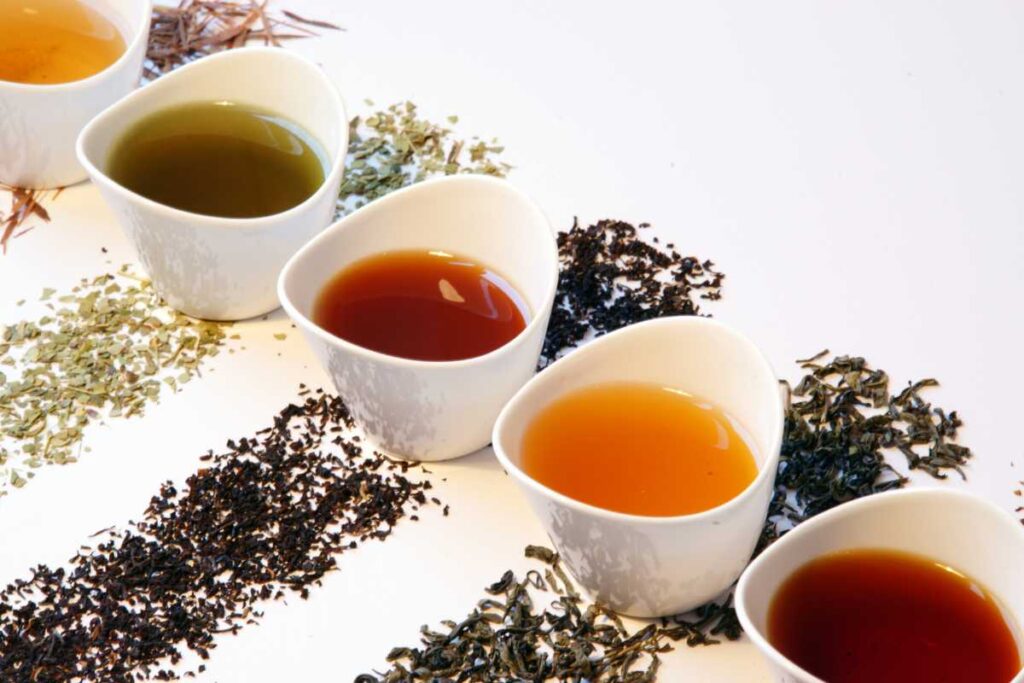Types of Tea: Your Ultimate Guide to Tea Varieties

Tea is one of the most popular beverages worldwide, with a rich history and many varieties to choose from. There are different kinds of tea available, including tisanes, rooibos, and yerba mate, each with its own unique flavor profile and health benefits. Some popular tea varieties include black tea, white tea, and chai tea. The production process for each type of tea varies, with some teas being fermented or oxidized while others are not.
Black teas, including popular English breakfast tea, are known for their strong flavor and dark color. They are made by fully fermenting the tea leaves before they are packaged. Other types of tea include masala chai, oolongs, rooibos, and yerba mate.
White teas, as well as many types of tisanes and oolongs, are becoming increasingly popular due to their delicate flavors and potential health benefits. Made from young leaves that have not yet fully opened, white teas undergo minimal processing before they are dried and packaged. Silver needle and pai mu tan are two examples of white teas that have gained popularity in recent years. Masala chai, a type of spiced tea, is also a favorite among tea drinkers.
Chai tea is one of the popular varieties that originated in India and is enjoyed by many types of tea drinkers. This spiced tea typically contains a blend of black tea leaves along with spices like cinnamon, cardamom, ginger, and cloves. Chai can be enjoyed hot or cold and is often sweetened with honey or sugar. For those looking for a caffeine-free option, rooibos tea is a great alternative.
In addition to these three main types of tea – black, white, and chai – there are many other types to choose from as well. Green tea is another popular variety that has been consumed for centuries due to its potential health benefits. Oolong teas fall somewhere between green teas and black teas in terms of oxidation levels. Some other examples include rooibos tea, which is naturally caffeine-free, and the level of oxidization can vary greatly depending on the desired flavor profile.
Pu-erh (or erh) tea is a fermented variety that has been gaining popularity in recent years due to its unique earthy flavor profile. Herbal teas like chamomile or peppermint do not contain any actual “tea” leaves but are instead made from herbs, flowers, and other plant parts. Rooibos is another popular tea that is caffeine-free and has a distinct taste. If you’re looking for a caffeine boost, Pu-erh is a great choice. You can find different styles of tea at your local shop.
The Six Types of Tea: Flavors, Processing, and Examples
White Tea: Delicate and Subtle Flavor
White tea is one of the popular varieties of tea, known for its delicate and subtle flavor profile. It is the least processed type of tea, which means it retains more of its natural taste. The leaves are picked when they are still young and covered in fine white hairs, hence the name “white” tea. This type of tea has a low caffeine content, making it perfect for those who prefer a lighter taste. If you’re looking for other caffeine-free options, you may want to try rooibos. Visit our shop to explore our range of teas.
Some varieties of white tea include Silver Needle, White Peony, and Shou Mei. Silver Needle is made from only the youngest buds of the tea plant and has a sweet, delicate taste. White Peony is made from both buds and leaves, giving it a slightly stronger flavor than Silver Needle. Shou Mei is made from larger leaves that have been left to mature longer than other types of white tea, resulting in a bolder taste. If you’re looking for a low-caffeine option, white tea is a great choice. You can find these varieties at your local tea shop.
Green Tea: Grassy and Vegetal Flavor
Green tea, one of the most popular varieties of tea, is unoxidized, which means it retains its green color and grassy vegetal flavor profile. It’s often described as having a light body with a refreshing taste, and contains caffeine which can provide an energy boost. Green tea is also known for its health benefits due to high levels of antioxidants, including the unique variety called erh.
Some popular varieties of green tea, known for their caffeine content, include Dragonwell (Longjing), Sencha, and Matcha. Dragonwell originates in China and has a nutty flavor with hints of chestnut, while also providing a moderate amount of caffeine. Sencha comes from Japan and has a fresh grassy taste with slight bitterness, and is also known for its caffeine boost. Matcha is made by grinding whole green tea leaves into powder form, resulting in an earthy taste that’s perfect for lattes or smoothies, and contains a high amount of caffeine.
Oolong Tea: Range of Flavors
Oolong tea, one of the popular varieties, falls somewhere between green and black teas in terms of oxidation level. It can have a wide range of flavors depending on how much oxidation occurs during processing – anywhere from floral to nutty to fruity. Oolong tea also contains caffeine for those who need a little boost.
Some examples of oolong teas, which contain caffeine, include Tie Guan Yin (Iron Goddess), Da Hong Pao (Big Red Robe), and Oriental Beauty. Tie Guan Yin is a popular Chinese oolong with a floral aroma and sweet taste that also provides a moderate amount of caffeine. Da Hong Pao is another Chinese oolong that has a roasted flavor with hints of caramel and a caffeine boost. Oriental Beauty, also known as Bai Hao Oolong, comes from Taiwan and has a unique honey-like taste while still containing caffeine.
Black Tea: Bold and Robust Flavor
Black tea, one of the most popular varieties of tea, is fully oxidized, resulting in its characteristic bold and robust flavor profile. It’s often described as having a full body with notes of malt or even chocolate. Black tea is perfect for those who prefer a stronger taste and a moderate amount of caffeine.
Some popular varieties of black tea, known for their caffeine content, include Assam, Darjeeling, and Earl Grey. Assam originates in India and has a malty flavor with hints of caramel, while also providing a strong dose of caffeine. Darjeeling comes from the Darjeeling region in India and has a light body with floral notes, as well as a moderate amount of caffeine. Earl Grey is made by adding bergamot oil to black tea leaves, resulting in a citrusy aroma and taste, along with a boost of caffeine.
Yellow Tea: Rare Type of Tea
Yellow tea is a rare variety compared to other popular varieties of tea due to its difficult processing method. It’s similar to green tea but undergoes an additional step where the leaves are wrapped in cloth or paper to allow them to yellow slightly before being dried.
Huangshan Maofeng (Yellow Mountain Fur Peak) is one of the popular varieties of yellow tea that comes from China’s Anhui province. It has a delicate nutty flavor with subtle floral notes.
Dark Tea: Fermented Tea
Dark tea, also known as fermented or post-fermented tea, is one of the popular varieties of tea that undergoes microbial fermentation during processing. This results in its characteristic earthy flavor profile that’s often described as “mushroomy” or “woody.” You can find this tea on Amazon.
Pu-erh is one of the popular varieties of dark tea that comes from China’s Yunnan province. It can be aged for years or even decades, resulting in a complex flavor profile that’s highly prized by tea connoisseurs.
Camellia Sinensis: The Tea Plant Responsible for Types of Tea
The Camellia Sinensis plant is the source of all types of tea, including popular varieties like black, green, white, and oolong. This plant is native to China and has been cultivated for thousands of years in countries like Sri Lanka and South America. Although chamomile, hibiscus, and other tisanes may be called “tea,” they are not made from the Camellia Sinensis plant and are instead considered herbal infusions.
The Camellia Sinensis plant has two main varieties: sinensis and assamica. The sinensis variety is more commonly used in Chinese teas, while the assamica variety is typically used in Indian teas. However, both varieties can be found in various teas worldwide.
Black tea is one of the most popular types of tea globally. It originated from China’s Fujian province during the Ming Dynasty (1368-1644) but was later produced on a large scale by British colonizers in India around 1835. To produce black tea, the leaves undergo a process called oxidation where they are withered, rolled, oxidized, and dried. This results in a dark-colored leaf with a robust flavor profile.
Green tea is another popular type of tea that originated from China’s Zhejiang province during the Tang Dynasty (618-907). Unlike black tea, green tea leaves are not oxidized but instead steamed or pan-fried to prevent oxidation. This process retains more of the natural vegetal flavor profile and provides health benefits such as antioxidants.
White tea is one of the popular varieties of rare teas globally due to its delicate nature and minimal processing required to produce it. It originates from China’s Fujian province but can also be found in other parts of Asia such as India and Sri Lanka. White tea leaves undergo minimal processing after being plucked from the Camellia Sinensis plant, resulting in a delicate flavor profile with subtle floral notes.
Oolong tea is a partially oxidized tea that originated from China’s Fujian province. It undergoes a more complicated production process than black or green tea, which involves partial oxidation and multiple rounds of rolling and drying. This results in a unique flavor profile that varies depending on the level of oxidation.
Oxidization, Firing/Drying, Rolling: The Tea-Making Process
Oxidation, Firing/Drying, Rolling: The Tea-Making Process
Oxidation process is a crucial step in tea-making, where the leaves are left to wither and undergo enzymatic changes. During this process, the enzymes present in the tea leaves break down the cell walls and release their contents. The oxidation process is responsible for creating different types of teas.
Fermented teas like black tea undergo full oxidation, while oolongs are partially oxidized. Black tea is made by withering fresh tea leaves and then rolling them to release their juices. After that, they are left to ferment for several hours before being fired or dried at high temperatures to stop the fermentation process. This results in a dark-colored leaf with a strong aroma and flavor.
On the other hand, oolong tea is produced by only partially oxidizing fresh tea leaves. The processing method involves withering the leaves under direct sunlight and then shaking them in bamboo baskets to bruise them slightly. This causes some of the leaves’ cell walls to break down and release their juices, which then react with oxygen in the air to create an array of flavors.
Firing/drying is a crucial step in tea production to halt the oxidation process and eliminate excess moisture from the leaves of tea plants. After partial oxidation or fermentation, it is essential to dry out or fire up the leaves immediately, so they do not continue reacting with oxygen in the air. This process is vital to maintain the quality of herbal tea flavor. Drying or firing can be accomplished through various methods such as sun-drying or oven drying.
Rolling is a key processing method that shapes the tea leaves and enhances their flavor and aroma. By rolling freshly picked green tea leaves between two flat surfaces repeatedly until they become twisted into thin strips, it helps break down cell walls more efficiently than just simply crushing them into pieces.
To brew tea, boiling water is used for black teas while lighter teas like green and white require water at lower temperatures. Boiling water is ideal for black teas because it helps extract the full flavor and aroma from the leaves. On the other hand, lighter teas like green and white require lower temperatures to preserve their delicate flavors.
Loose Leaf vs. Tea Bags: Which is Better?
There are two main options: loose leaf and tea bags. While both can produce a satisfying cup of tea, there are some key differences between the two that may make one better than the other depending on your preferences.
Higher Quality Flavor Profile with Loose Leaf Teas
Loose leaf teas are made from whole, unbroken tea leaves that have been minimally processed. This means that they retain more of their natural oils and flavors compared to tea bags, which contain smaller, broken pieces of tea leaves. As a result, loose leaf teas generally have a higher quality flavor profile and more complex taste than their bagged counterparts.
In addition to the superior taste experience, loose leaf teas also offer more variety in terms of flavor options. With whole leaves, you can experiment with different brewing methods and steeping times to bring out unique nuances in each type of tea.
Environmental Benefits of Loose Leaf Tea
Another advantage of loose leaf tea is its environmental friendliness. Tea bags often come packaged in individual sachets or wrapped in plastic packaging, which contributes to unnecessary waste. In contrast, loose leaf teas usually come in recyclable paper or metal containers that can be reused or recycled after use.
Moreover, when you brew loose leaf tea, you don’t need to use a disposable filter like you do with teabags. Instead, you can use reusable metal strainers or muslin bags for steeping your fresh tea leaves.
Cost-Effective Option with Loose Leaf Teas
While loose leaf teas may seem more expensive upfront compared to teabags per ounce or gram due to their higher quality ingredients and production process costs; however they are actually cost-effective option in the long run as they are reusable for multiple cups and infusions unlike teabags which only give one-time usage.
How to Steep and Serve Different Varieties of Tea
Different Types of Tea and How to Steep and Serve Them
Steeping a perfect cup of tea requires precision, patience, and knowledge of the type of tea you are brewing. Each variety has its unique flavor profile, aroma, and color that can be enhanced by steeping it correctly. In this section, we will discuss how to steep and serve different types of tea.
Black Tea: Best Served with Milk and Sugar
Black tea is known for its bold taste and high caffeine content. To brew black tea, bring water to a rolling boil (100°C) in a kettle or pot. Add loose-leaf black tea or teabags to the boiling water and let it steep for 3-5 minutes. Longer steeping times can result in bitter-tasting tea. Once the time is up, remove the teabag or strain out the leaves using a mesh strainer.
Black tea is best served with milk and sugar as they complement its strong flavor. Add milk before pouring hot water into the cup; this helps prevent curdling. Stir in sugar or honey according to your preference.
Green Tea: Typically Enjoyed Plain
Green tea is known for its delicate flavor and low caffeine content. To brew green tea, heat water until it reaches 75-80°C (not boiling). Add loose-leaf green tea or teabags to a teapot or infuser basket; use one teaspoon per cup of water. Let it steep for 1-3 minutes depending on how strong you like your tea.
Green tea is typically enjoyed plain without any additions such as milk or sugar as they can overpower its subtle taste.
Herbal Tea: Can Be Steeped for Longer Periods
Herbal teas come in various flavors such as mint, chamomile, lavender, ginger, etc., depending on the herbs used to make them. To brew herbal teas, bring fresh cold water to boil (100°C) and add loose-leaf herbs or teabags to a teapot or infuser basket. Let it steep for 5-10 minutes; longer steeping times won’t make the tea bitter as it does with other types of tea.
Herbal teas can be enjoyed plain or sweetened with honey or sugar according to your preference.
Health Benefits of Different Types of Tea
Herbal teas have been reported to have various health benefits. Unlike other types of tea, herbal tea is not made from the leaves of the Camellia sinensis plant. Instead, it is made from a variety of dried flowers, fruits, and herbs. One of the most popular herbal teas is chamomile tea which has been known to aid in digestion and promote relaxation.
Another type of tea that has gained popularity in recent years is rooibos tea. Also known as red tea, rooibos tea comes from South Africa and is known for its antioxidant properties. It contains high levels of flavonoids that help protect against oxidative stress and inflammation in the body.
Some tea blends are specifically formulated to promote certain health benefits. For example, hibiscus tea has been shown to lower blood pressure while ginger tea can help with nausea and digestive issues. These blends often combine different types of herbs and spices to create a unique flavor profile while also providing specific health benefits.
Drinking other teas such as green and black tea may help reduce the risk of chronic diseases. Green tea contains catechins that have been shown to reduce inflammation in the body while black tea contains compounds called theaflavins that may help lower cholesterol levels.
The health benefits of different types of teas may vary depending on an individual’s overall health and lifestyle. For example, those who are sensitive to caffeine should avoid drinking large amounts of black or green teas as they contain higher levels of caffeine than other types of teas.
Appreciating the Unique Characteristics of Each Type of Tea
Tea drinkers appreciate the unique characteristics of each type of tea. From purple teas to popular varieties like Earl Grey, there is a vast range of flavors and brews that can be appreciated in the same way as wine. In this section, we will explore some of the exciting things about different kinds of tea.
Purple Teas: A Unique and Rare Variety
Purple teas are a rare variety that offers a distinct flavor profile. They are grown in the Yunnan province of China and are known for their dark color. The leaves get their purple hue from anthocyanins, which are natural pigments found in plants. These teas have a smooth taste with hints of sweetness and floral notes. Purple teas also have health benefits due to their high levels of antioxidants.
Different Kinds of Tea Require Different Brewing Styles and Times
To bring out the best qualities in different types of tea, it’s essential to use the right brewing style and time. For example, green tea should be brewed at a lower temperature for a shorter time than black tea. Silver needle white tea requires an even lower temperature than green tea because it is delicate and can easily become bitter if over-brewed.
Popular Varieties like Earl Grey Have Rich History
Earl Grey is one of the most popular varieties of tea worldwide; it has a rich history dating back to the 1800s when Charles Grey was given a special blend by Chinese diplomats. This blend included bergamot oil, which gave it its signature citrusy flavor. Today, Earl Grey is enjoyed by many tea enthusiasts worldwide.
Tea Is Like Wine: It Has A Range Of Flavors And Brews That Can Be Appreciated In The Same Way
Just like wine, different types of tea have various flavors and brews that can be appreciated in the same way. Whether you enjoy black or green tea or prefer something more exotic like pu-erh or oolong, there is a tea out there for everyone. As you explore the world of tea, you will discover that each type has its unique characteristics and flavor profile.
Matcha Green Tea: Popular and Healthy Type of Green Tea
Matcha tea is a type of green tea that has gained immense popularity worldwide due to its unique taste, health benefits, and versatility. In this section, we will discuss what matcha tea is, how it is made, its health benefits, and why it has become so popular.
What is Matcha Tea?
Matcha tea is a type of green tea that comes from Japan. Unlike other types of green teas, matcha is made from finely ground green tea leaves that are grown in the shade for several weeks before being harvested. The shading process increases the chlorophyll content in the leaves and gives them a bright green color. After harvesting, the leaves are steamed to stop fermentation and then dried before being ground into a fine powder.
How Matcha Tea is Made?
The process of making matcha tea involves whisking the powdered tea with hot water until it forms a frothy mixture. This method ensures that you consume all the nutrients present in the leaves as you drink the whole leaf rather than just steeping them like traditional teas.
Health Benefits of Matcha Tea
Matcha tea contains numerous health benefits due to its high concentration of antioxidants and amino acids such as L-theanine. These compounds help boost metabolism, improve brain function, reduce stress levels, promote relaxation without drowsiness or jitters associated with coffee consumption.
Why Matcha Tea has Become So Popular?
Apart from its unique taste and various health benefits, matcha’s versatility makes it an excellent ingredient for different recipes such as lattes, smoothies, ice cream, cakes etc. It can also be used as an alternative to coffee or energy drinks since it provides natural energy without any side effects. Matcha is one of the most popular teas and its distinct tea flavor blends well with other herbal teas.
Conclusion: Types of Tea and Their Unique Characteristics
From the earthy and robust black tea to the delicate and floral white tea, each type of tea has its own unique characteristics that make it a beloved beverage for millions of people around the world. The Camellia Sinensis plant, responsible for producing all types of tea, undergoes different processing methods to create the distinct flavors and aromas that we love.
Loose leaf tea or tea bags? The debate is ongoing, but ultimately, it comes down to personal preference. However, steeping and serving various teas require different techniques to bring out their full potential. Knowing how to properly steep and serve each type of tea can enhance your overall experience.
Aside from their delicious taste, different types of tea also offer various health benefits such as reducing inflammation, aiding digestion, boosting immunity, improving heart health and more. Matcha green tea has gained popularity in recent years due to its high concentration of antioxidants.
Appreciating the unique characteristics of each type of tea is essential in understanding why they are so special. From the smoky notes in black tea to the grassy undertones in green tea, every cup offers a sensory experience like no other.




